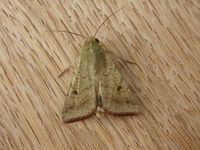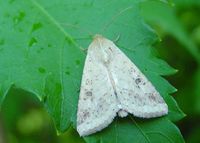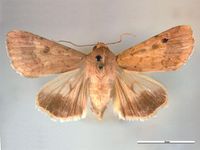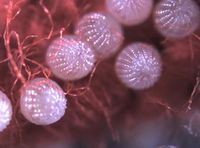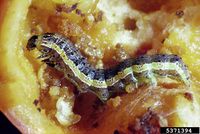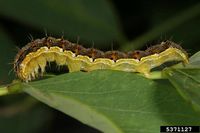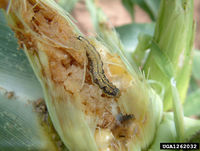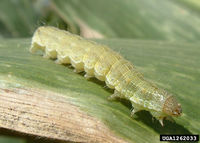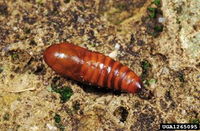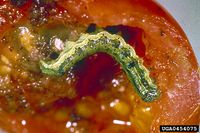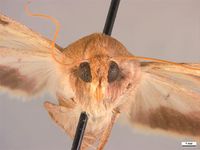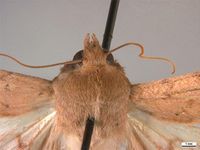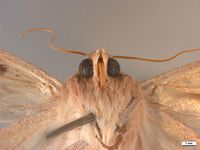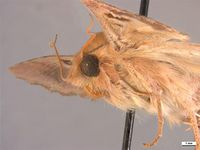Difference between revisions of "Helicoverpa armigera"
| Line 3: | Line 3: | ||
[[File:Helicoverpa_armigera_3.jpg|300px|thumb|''Helicoverpa armigera'' (on the hind wing, the pale spot inside the dark border is typical of ''H. armigera'' (in contrast to related species like ''H. punctigera'')<br/>Author: Donald Hobern<br/>Source:[http://commons.wikimedia.org/wiki/File:Helicoverpa_armigera_3.jpg Wikimedia Commons]]] | [[File:Helicoverpa_armigera_3.jpg|300px|thumb|''Helicoverpa armigera'' (on the hind wing, the pale spot inside the dark border is typical of ''H. armigera'' (in contrast to related species like ''H. punctigera'')<br/>Author: Donald Hobern<br/>Source:[http://commons.wikimedia.org/wiki/File:Helicoverpa_armigera_3.jpg Wikimedia Commons]]] | ||
<font color="#800000">'''''Helicoverpa armigera'''''</font> (Hübner, 1808) (old world cotton bollworm)<br/> | <font color="#800000">'''''Helicoverpa armigera'''''</font> (Hübner, 1808) (old world cotton bollworm)<br/> | ||
| − | is widespread in southern Europe, Africa, Asia and Australia/Pacific, where it is a serious, highly polyphagous pest of cotton, maize, tomatoes and many other crops. It is also found in central and even northern Europe during the summer. It is frequently intercepted by quarantine in America and since 2012 has been recorded from north-eastern Brazil where substantial crop damage has been reported. | + | is widespread in southern Europe, Africa, Asia and Australia/Pacific, where it is a serious, highly polyphagous pest of cotton, maize, tomatoes and many other crops. It is also found in central and even northern Europe during the summer. It is frequently intercepted by quarantine in America and since 2012 has been recorded from north-eastern Brazil where substantial crop damage has been reported ([[Journal of Economic Entomology (2014) 107, 970-980|Mastrangelo et al., 2014]]). |
The larvae prefer the buds, flowers and fruits, but may also damage the leaves. On cotton, it bores into the bolls, causing shedding of the bolls and inferior lint quality. The species is considered economically to be one of the most important insect pests world-wide. The insect is found in a wide range of climates and has adapted to tropical, subtropical and temperate conditions. The development time for the larvae lasts from about 30 days at 20°C to about 20 days at 25°C. In temperate regions, it might enter a pupal diapause during the winter. Under favourable conditions the total development time from egg, over 6-7 larval stages, to mature adult might be as short as 5-6 weeks and the insect can go through up to 4 generations per year. | The larvae prefer the buds, flowers and fruits, but may also damage the leaves. On cotton, it bores into the bolls, causing shedding of the bolls and inferior lint quality. The species is considered economically to be one of the most important insect pests world-wide. The insect is found in a wide range of climates and has adapted to tropical, subtropical and temperate conditions. The development time for the larvae lasts from about 30 days at 20°C to about 20 days at 25°C. In temperate regions, it might enter a pupal diapause during the winter. Under favourable conditions the total development time from egg, over 6-7 larval stages, to mature adult might be as short as 5-6 weeks and the insect can go through up to 4 generations per year. | ||
Revision as of 18:49, 24 August 2014
| Literature database |
|---|
| 1449 articles sorted by: |
| • year (recent ones first) |
| • research topics |
| • countries/regions |
| • host plants |
| • list of natural enemies |

Author: Donald Hobern
Source:Wikimedia Commons
Helicoverpa armigera (Hübner, 1808) (old world cotton bollworm)
is widespread in southern Europe, Africa, Asia and Australia/Pacific, where it is a serious, highly polyphagous pest of cotton, maize, tomatoes and many other crops. It is also found in central and even northern Europe during the summer. It is frequently intercepted by quarantine in America and since 2012 has been recorded from north-eastern Brazil where substantial crop damage has been reported (Mastrangelo et al., 2014).
The larvae prefer the buds, flowers and fruits, but may also damage the leaves. On cotton, it bores into the bolls, causing shedding of the bolls and inferior lint quality. The species is considered economically to be one of the most important insect pests world-wide. The insect is found in a wide range of climates and has adapted to tropical, subtropical and temperate conditions. The development time for the larvae lasts from about 30 days at 20°C to about 20 days at 25°C. In temperate regions, it might enter a pupal diapause during the winter. Under favourable conditions the total development time from egg, over 6-7 larval stages, to mature adult might be as short as 5-6 weeks and the insect can go through up to 4 generations per year.
| Vernacular names | |
|---|---|
| • Deutsch: | Baumwollkapselwurm |
| • English: | old world cotton bollworm African bollworm gram pod borer |
| • Español: | oruga del tomate |
| • Français: | noctuelle de la tomate |
The adults have a wingspan of 3½-4 cm. There is considerable variation in colour both on the adults and the caterpillars, the latter reach a length of about 4 cm. It its most closely related to Helicoverpa zea of the New World and both species interbreed in the laboratory.
Synonyms:
Heliothis armigera
Heliothis obsoleta
For more details see the respective page in Wikipedia.
- Other images of Helicoverpa armigera (Wikimedia Commons, IPM Images and PaDIL - click to enlarge)
